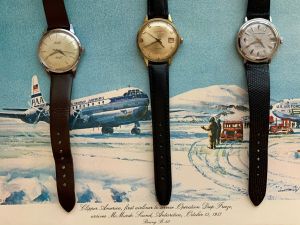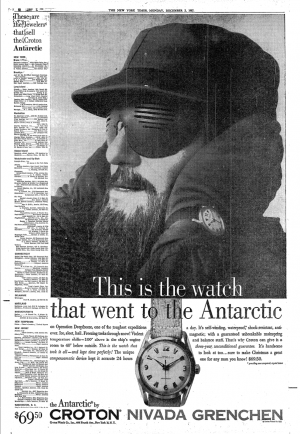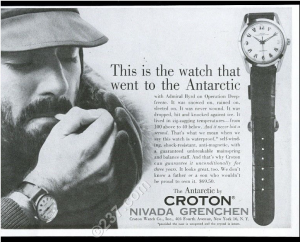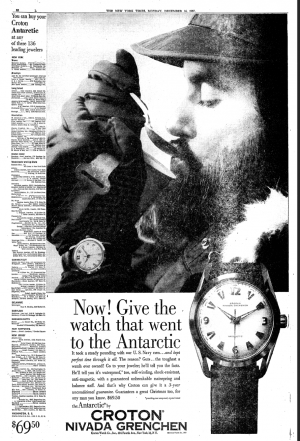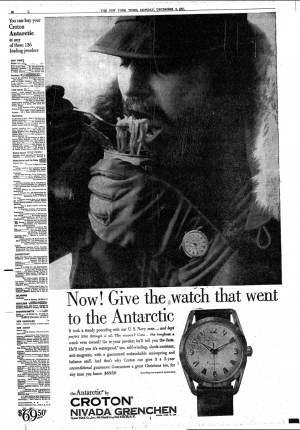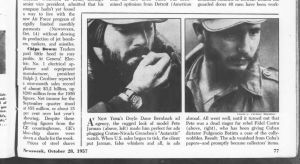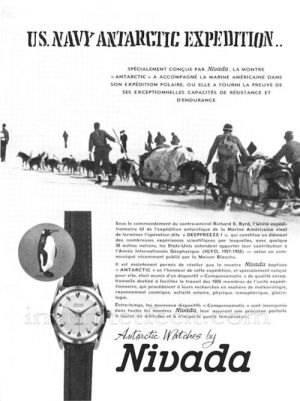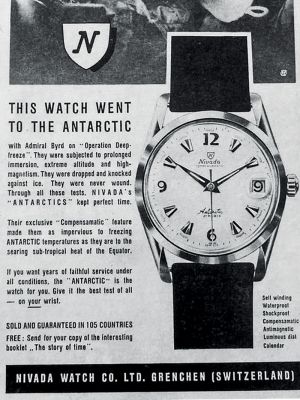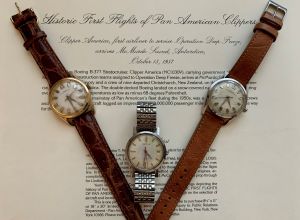Difference between revisions of "Nivada Antarctic"
m |
|||
| (19 intermediate revisions by 4 users not shown) | |||
| Line 1: | Line 1: | ||
| − | [[File:Clippermenu1.jpg|thumb|A Group of Antarctic Watches on a Menu from the First Flight to Antarctica 1957]] | + | [[File:Clippermenu1.jpg|thumb|A Group of Antarctic Watches on a Menu from the First Flight to Antarctica 1957 - Richard Phillips Collection]] |
| − | ==Nivada Antarctic== | + | ==Nivada Antarctic and Operation Deep Freeze== |
| − | [[File: | + | [[File:Screenshot (51).png|thumb]] |
| − | + | The Nivada Antarctic was one of a handful of groundbreaking tool watches developed in the 1950s during the post-WWII age of exploration. [[Rolex]] sent their Explorer with Hillary and Norgay on their ascent of Everest in 1953 and their [https://www.esquire.com/uk/watches/a33818711/tudor-british-north-greenland-arctic/ Tudor 7809 on the British North Greenland Expedition] in 1952-54, [[Vulcain]] accompanied the [https://www.watchonista.com/vulcain/news/historical-background-ascent-k2 assault on K2] in 1954, and [[Enicar]] was there for the [https://enicar.org/2018/07/02/birth-of-the-sherpa-the-1956-mount-everest-expedition/ climbing of Lhotse] in 1956. | |
| − | + | That decade's crowning event of exploration was the [https://en.wikipedia.org/wiki/International_Geophysical_Year International Geophysical Year] (IGY), an international scientific project that was announced in 1952 and took place from July 1957 to December 1958. IGY involved sixty-seven countries, including the United States, the Soviet Union, and most of Europe. It was primarily a collaborative scientific undertaking to explore the Earth’s poles, climb the tallest mountains, probe the ocean depths, and advance the exploration of space. But it was inevitably competitive, as well—Sputnik 1 was launched during IGY after all. | |
| − | In 1958, JLC sent their now famous Geophysic Chronometer with the USS Nautilus nuclear submarine on its journey under the North Pole | + | The watch industry was right there too. Wristwatches were becoming more capable of highly accurate timekeeping, as well as being exposed to extremes of temperature and water depth. This made IGY a perfect opportunity for watch manufacturers to address the growing needs of the scientific community—and, not incidentally, to market watches to the public who were following the exploits of IGY scientists in the news. Two manufacturers in particular took advantage of IGY: [[Jaeger-LeCoultre]] (JLC) and [[Nivada]]. In 1958, JLC sent their now-famous [https://www.hodinkee.com/articles/the-jaeger-lecoultre-geophysic-worn-by-captain-anderson Geophysic Chronometer with the USS Nautilus] nuclear submarine on its journey under the North Pole. |
| + | |||
| + | [[Nivada]], meanwhile, sent a watch to the Antarctic. One of the United States’s IGY goals was to establish the first permanent base at the South Pole. Preparation began with [https://en.wikipedia.org/wiki/Operation_Deep_Freeze Operation Deep Freeze I] (ODF I), which took place over the polar summer from November 1955 through April 1956. ODF I’s mission was to establish a coastal Antarctic base at McMurdo Sound, which would serve as the logistical hub for the eventual Pole base and IGY operations. | ||
| + | |||
| + | ODF I was a U.S. Navy operation, headed by the famous aviator and polar explorer [https://en.wikipedia.org/wiki/Richard_E._Byrd Admiral Richard E. Byrd], who was then in the last days of his remarkable career. Operations were handled by Task Force 43, commanded by [https://en.wikipedia.org/wiki/George_J._Dufek Rear Admiral George J. Dufek]. Admiral Byrd himself spent only one week in Antarctica during ODF I, inspecting McMurdo Station in late April 1956. He died the following year, in March 1957. | ||
| + | |||
| + | ODF I required a watch with advanced water-resistant, shock-resistant, and anti-magnetic properties, and the Nivada Antarctic was made accordingly. Further research is required to determine exactly how many watches were requisitioned for ODF I and to whom they were provided. Period advertising predictably emphasized Admiral Byrd, but given the scope of the watches' reported use and ODF I’s operational structure, Rear Admiral Dufek and his men would seem to be likely additional recipients. As one advertisement proclaimed: “They were subjected to prolonged immersion, extreme altitude and high magnetism. They were dropped and knocked against ice. They were never wound. Through all these tests, Nivada’s Antarctics kept perfect time.” | ||
| + | |||
| + | Indeed, period advertising for the Antarctic provides its own interesting side story. After successfully testing the watch during ODF I, Nivada went into marketing high gear, hiring the renowned ad firm Doyle Dane Bernbach—famous for creating [https://en.wikipedia.org/wiki/Daisy_(advertisement) LBJ’s nuclear armageddon “Daisy” commercial]. DDB created a series of Antarctic print ads featuring Madison Avenue’s vision of a rugged polar explorer, a model named Peter Jarman sporting a fake beard. Nivada’s investment was substantial, as several of the ads ran full-page in the New York Times beginning on June 8, 1957. The ads, reproduced here, depict among other things Jarman lighting a cigarette, sporting futuristic solar shades, and peering through binoculars. The investment apparently paid off: according to the October 28, 1957 edition of Newsweek, the ads were so successful Nivada decided to run them internationally, leading to a minor controversy when Cuban dictator Fulgencio Batista banned them because he thought Jarman too closely resembled then-rebel Fidel Castro. As usual, advertising doesn't necessarily reflect reality (except with respect to beards, apparently): compare a real-life member of ODF 63 wearing an Antarctic tundra dial while decorating a Chirstmas tree at McMurdo Station in 1963. | ||
| + | [[File:DDB visor.png|thumb]] | ||
| + | [[File:1957 ad for croton aquamatic antarctic (1).png|thumb]] | ||
| + | [[File:Screenshot (48).png|thumb]] | ||
| + | [[File:Screenshot (50).png|thumb]] | ||
| + | [[File:Page 77 from Newsweek (US Edition) 1957-10-28 Vol 50 Iss 18.jpg|thumb]] | ||
| + | [[File:USARP member DF63.jpg|thumb|USARP DF63 McMurdo (Antartcic Tundra Dial)]] | ||
| + | |||
| + | The original first issue Antarctic is small by today’s standards, with the stainless steel case measuring 34mm wide by 44mm long with 18mm lugs. A variant with a stepped (rather than flat) case back also comes in at 34mm but is 42mm long with 17mm lugs—a noticeable difference when compared side-to-side. Both case backs screw in, and the standard flat back has a polygon shaped ridge for the back removal tool. This is a great design if you have the exact tool, but can be problematic for those not using the proper wrench, which leaves this style of case back susceptible to marks and gouges. The stepped case back has six recesses for a standard removal tool. The lugs are very distinctive. At first glance they look a little like bombe lugs, but they are quite different. They are rounded on the side with a flat cut on top that gives them their unique angular look. | ||
| + | |||
| + | The Antarctic was quite successful, becoming one of Nivada’s most well-known models, along with the [[Croton Nivada Grenchen Chonomaster|Chronomaster Aviator Sea Diver]]. [[Nivada]] ended up having trouble with [[Movado]] regarding their name, and were forced to change it to Nivada Grenchen. They then teamed up with [[Croton]] for distribution. That’s why you’ll see watches branded Nivada, Nivada Grenchen, and Croton Nivada Grenchen. Nivada (et al) produced different Antarctic variants—some with date, some without, as well as several different dial designs. | ||
[[File:Croton antarctice date.jpg|thumb]] | [[File:Croton antarctice date.jpg|thumb]] | ||
| − | |||
| − | |||
| − | |||
==Nivada Antarctic Models== | ==Nivada Antarctic Models== | ||
| − | * [[Nivada Antarctic Models|Antarctic Series One to Four]] - Click here to read more about the early models. | + | * [[Nivada Antarctic Models|Antarctic Series One to Four]] - Click here to read more about the early models from 1956 to 1964. |
| − | [[Nivada Antarctic Late Models]] - Antarctic named models 1964 to 1978 | + | * [[Nivada Antarctic Late Models]] - Antarctic named models 1964 to 1978 |
* [[Nivada Antarctic Chronometre]] | * [[Nivada Antarctic Chronometre]] | ||
*[[Nivada Antarctic Diver Models]] | *[[Nivada Antarctic Diver Models]] | ||
| − | + | [[File:CFD5362F-1FD4-41CD-B10A-F056F2F5B8A4.jpg|thumb|First series gold with later Antarctic font]] | |
CREDIT - https://wornandwound.com/affordable-vintage-croton-nivada-grenchen-antarctic/ | CREDIT - https://wornandwound.com/affordable-vintage-croton-nivada-grenchen-antarctic/ | ||
[[File:Late+antarctic+advert.jpg|thumb]] | [[File:Late+antarctic+advert.jpg|thumb]] | ||
| + | [[File:Nivada-Grenchen-Antarctic-Newspaper-Clipping-3.jpg|thumb]] | ||
==Links== | ==Links== | ||
| Line 31: | Line 47: | ||
Credits and Further Reading - https://www.vintagenivada.com/ | Credits and Further Reading - https://www.vintagenivada.com/ | ||
| − | [[File:Clippermenu2.jpg|thumb|Trip of Antarctic watches on the menu from PanAm first flight to Operation Deep Freeze 1957]] | + | [[File:Clippermenu2.jpg|thumb|Trip of Antarctic watches on the menu from PanAm first flight to Operation Deep Freeze 1957- Richard Phillips Collection]] |
| + | |||
| + | |||
| + | [[File:Antarctic.JPG|thumb|CNG Antarctic mid size model, 30mm in diameter, with all stainless steel case, automatic ETA 2451 movement, dauphine hands with blued seconds hand and radium dial with vertical striated grain pattern. Original crown replaced, otherwise a very nice example.]] | ||
Latest revision as of 04:28, 2 April 2024
Nivada Antarctic and Operation Deep Freeze
The Nivada Antarctic was one of a handful of groundbreaking tool watches developed in the 1950s during the post-WWII age of exploration. Rolex sent their Explorer with Hillary and Norgay on their ascent of Everest in 1953 and their Tudor 7809 on the British North Greenland Expedition in 1952-54, Vulcain accompanied the assault on K2 in 1954, and Enicar was there for the climbing of Lhotse in 1956.
That decade's crowning event of exploration was the International Geophysical Year (IGY), an international scientific project that was announced in 1952 and took place from July 1957 to December 1958. IGY involved sixty-seven countries, including the United States, the Soviet Union, and most of Europe. It was primarily a collaborative scientific undertaking to explore the Earth’s poles, climb the tallest mountains, probe the ocean depths, and advance the exploration of space. But it was inevitably competitive, as well—Sputnik 1 was launched during IGY after all.
The watch industry was right there too. Wristwatches were becoming more capable of highly accurate timekeeping, as well as being exposed to extremes of temperature and water depth. This made IGY a perfect opportunity for watch manufacturers to address the growing needs of the scientific community—and, not incidentally, to market watches to the public who were following the exploits of IGY scientists in the news. Two manufacturers in particular took advantage of IGY: Jaeger-LeCoultre (JLC) and Nivada. In 1958, JLC sent their now-famous Geophysic Chronometer with the USS Nautilus nuclear submarine on its journey under the North Pole.
Nivada, meanwhile, sent a watch to the Antarctic. One of the United States’s IGY goals was to establish the first permanent base at the South Pole. Preparation began with Operation Deep Freeze I (ODF I), which took place over the polar summer from November 1955 through April 1956. ODF I’s mission was to establish a coastal Antarctic base at McMurdo Sound, which would serve as the logistical hub for the eventual Pole base and IGY operations.
ODF I was a U.S. Navy operation, headed by the famous aviator and polar explorer Admiral Richard E. Byrd, who was then in the last days of his remarkable career. Operations were handled by Task Force 43, commanded by Rear Admiral George J. Dufek. Admiral Byrd himself spent only one week in Antarctica during ODF I, inspecting McMurdo Station in late April 1956. He died the following year, in March 1957.
ODF I required a watch with advanced water-resistant, shock-resistant, and anti-magnetic properties, and the Nivada Antarctic was made accordingly. Further research is required to determine exactly how many watches were requisitioned for ODF I and to whom they were provided. Period advertising predictably emphasized Admiral Byrd, but given the scope of the watches' reported use and ODF I’s operational structure, Rear Admiral Dufek and his men would seem to be likely additional recipients. As one advertisement proclaimed: “They were subjected to prolonged immersion, extreme altitude and high magnetism. They were dropped and knocked against ice. They were never wound. Through all these tests, Nivada’s Antarctics kept perfect time.”
Indeed, period advertising for the Antarctic provides its own interesting side story. After successfully testing the watch during ODF I, Nivada went into marketing high gear, hiring the renowned ad firm Doyle Dane Bernbach—famous for creating LBJ’s nuclear armageddon “Daisy” commercial. DDB created a series of Antarctic print ads featuring Madison Avenue’s vision of a rugged polar explorer, a model named Peter Jarman sporting a fake beard. Nivada’s investment was substantial, as several of the ads ran full-page in the New York Times beginning on June 8, 1957. The ads, reproduced here, depict among other things Jarman lighting a cigarette, sporting futuristic solar shades, and peering through binoculars. The investment apparently paid off: according to the October 28, 1957 edition of Newsweek, the ads were so successful Nivada decided to run them internationally, leading to a minor controversy when Cuban dictator Fulgencio Batista banned them because he thought Jarman too closely resembled then-rebel Fidel Castro. As usual, advertising doesn't necessarily reflect reality (except with respect to beards, apparently): compare a real-life member of ODF 63 wearing an Antarctic tundra dial while decorating a Chirstmas tree at McMurdo Station in 1963.
The original first issue Antarctic is small by today’s standards, with the stainless steel case measuring 34mm wide by 44mm long with 18mm lugs. A variant with a stepped (rather than flat) case back also comes in at 34mm but is 42mm long with 17mm lugs—a noticeable difference when compared side-to-side. Both case backs screw in, and the standard flat back has a polygon shaped ridge for the back removal tool. This is a great design if you have the exact tool, but can be problematic for those not using the proper wrench, which leaves this style of case back susceptible to marks and gouges. The stepped case back has six recesses for a standard removal tool. The lugs are very distinctive. At first glance they look a little like bombe lugs, but they are quite different. They are rounded on the side with a flat cut on top that gives them their unique angular look.
The Antarctic was quite successful, becoming one of Nivada’s most well-known models, along with the Chronomaster Aviator Sea Diver. Nivada ended up having trouble with Movado regarding their name, and were forced to change it to Nivada Grenchen. They then teamed up with Croton for distribution. That’s why you’ll see watches branded Nivada, Nivada Grenchen, and Croton Nivada Grenchen. Nivada (et al) produced different Antarctic variants—some with date, some without, as well as several different dial designs.
Nivada Antarctic Models
- Antarctic Series One to Four - Click here to read more about the early models from 1956 to 1964.
- Nivada Antarctic Late Models - Antarctic named models 1964 to 1978
- Nivada Antarctic Chronometre
- Nivada Antarctic Diver Models
CREDIT - https://wornandwound.com/affordable-vintage-croton-nivada-grenchen-antarctic/
Links
Credits and Further Reading - https://www.vintagenivada.com/
